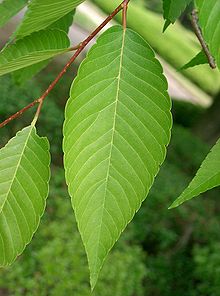| Zelkova | |
|---|---|

| |
| Zelkova serrata | |
| Scientific classification | |
| Kingdom: | Plantae |
| Clade: | Tracheophytes |
| Clade: | Angiosperms |
| Clade: | Eudicots |
| Clade: | Rosids |
| Order: | Rosales |
| Family: | Ulmaceae |
| Genus: | Zelkova Spach |
Zelkova (from the Georgian dzelkva, 'stone pillar') is a genus of six species of deciduous trees in the elm family Ulmaceae, native to southern Europe, and southwest and eastern Asia. They vary in size from shrubs (Z. sicula) to large trees up to 35 m (115 ft) tall (Z. carpinifolia). The bark is smooth, dark brown. Unlike the elms, the branchlets are never corky or winged. The leaves are alternate, with serrated margins, and (unlike the related elms) a symmetrical base to the leaf blade. The leaves are in two distinct rows; they have pinnate venation and each vein extends to the leaf margin, where it terminates in a tooth. There are two stipules at each node, though these are caducous (shed early), leaving a pair of scars at the leaf base. Zelkova is polygamous. Staminate flowers are clustered in the lower leaf axils of young branchlets; the perianth is campanulate, with four to six (to seven) lobes, and the stamens are short. Pistillate and hermaphrodite flowers are solitary, or rarely in clusters of two to four, in the upper leaf axils of young branchlets. The fruit is a dry, nut-like drupe with a dorsal keel, produced singly in the leaf axils. The perianth and stigma are persistent. [1][2][3][4]
- ^ Andrews, S. (1994). Tree of the year: Zelkova. Int. Dendrol. Soc. Yearbook 1993: 11-30.
- ^ de Spoelberch, P. (1994). Zelkova: More questions than answers. Int. Dendrol. Soc. Yearbook 1993: 30–33.
- ^ Hunt, D. (1994). Beware of the Zelkova. Int. Dendrol. Soc. Yearbook 1993: 33–41.
- ^ Rushforth, K. (1999). Trees of Britain and Europe. Collins. ISBN 0-00-220013-9.